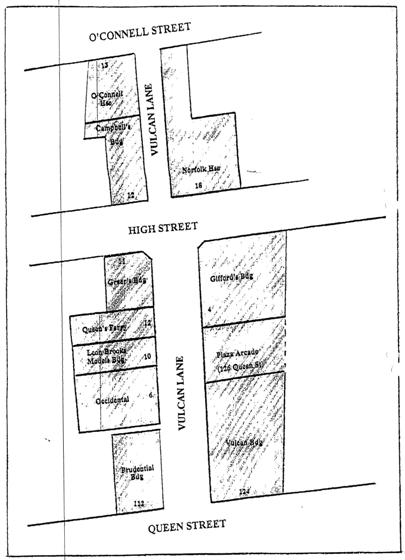GENERAL DESCRIPTION: Vulcan Lane has been shaped by its prominence as a busy pedestrian thoroughfare and place of social gathering, as well as its historical association with the growth of downtown Auckland. Vulcan Lane first appeared in Felton Matthews' plan of Auckland in 1841 as a narrow service alley linking Queen and High Streets, and as an access lane to the merchant houses in Shortland Crescent (later Street). At this stage it was an unnamed and muddy track. In 1846 a smithy, named Vulcan Forge by its owner, was installed in the High St corner. By 1850 the name Vulcan Lane was in popular use, although it was never officially bestowed on the lane. In the mid 1800s the largely pedestrian byway was an area of artisans' houses, workshops, grog shops and various merchants. A fire in 1850 destroyed much of the area, and redevelopment resulted in a shift of the commercial focus from the High St/Shortland Crescent area to Queen Street. During this stage Vulcan Lane developed a commercial character influenced by its strategic position between the old and new streets of commercial development. During the 1860's the upper portion of the lane (between High and O'Connell Sts) opened but it was not considered a public street with public works. For example, the laying of a sewer in 1865 was confined to the lower portion of the lane. In general the whole length of the lane was in a poor and unformed condition. In 1865 a license was granted to the Queen's Ferry Hotel, and a substantial wholesale warehouse was opened in the lane. In 1870 the Occidental Hotel opened and a block of chambers was erected on the Queen St corner. This improved building continued through to 1875 by which time there was complaints of growing congestion in the lane. Toward the end of the century (1890's), the overcrowded Vulcan Lane gained notoriety as a place of "evil population", but it also had premises for barristers, solicitors and other professionals with offices in the street. Vulcan Lane was now fully established in terms of its business nature. In the 1920's the lane was widened by about 15ft on the south side, and new commercial buildings were being erected in the area. Any new buildings constructed in the lane had to conform with the Council's requirements and hence the lane adopted a wider more spacious and sunlit appearance. In the next decade the commercial nature of Vulcan Lane flourished . However, after World War II motor traffic increased and buildings on the northern side of the lane began to show their age. There was less room for pedestrians and this resulted in a loss of attraction of the lane as a meeting place, so by the 1960's the lane became a pedestrian mall and was used for pedestrian traffic only. In recent years the mall has served as a gathering place for young people, for example, Auckland university students used the lane for classical busking in 1980 (subsequently banned a year later). Vulcan Lane makes a significant contribution to Auckland's inner city in terms of its streetscape and character, and as a social drawcard. Vulcan Lane has been a popular thoroughfare in Auckland since the 1850s, constantly changing with the development of the city. The group of buildings within the area vary in age and architectural style but are similar in height and scale. The area has townscape and landmark qualities as well as great historical significance.


Location
List Entry Information
Overview
Detailed List Entry
Status
Listed
List Entry Status
Historic Area
Access
Able to Visit
List Number
7011
Date Entered
12th December 1994
Date of Effect
12th December 1994
City/District Council
Auckland Council
Region
Auckland Council
Extent of List Entry
Buildings along each side of Vulcan Lane, from Queen St to High St (lower Vulcan Lane), and from High St to O'Connell St (upper Vulcan Lane).
Related listings
Stay up to date with Heritage this month
